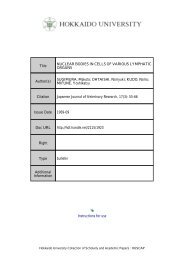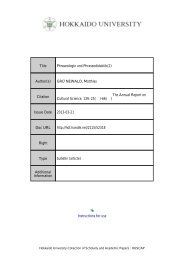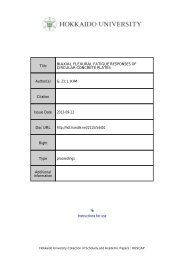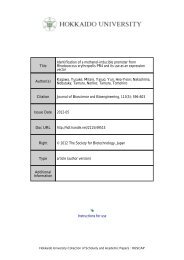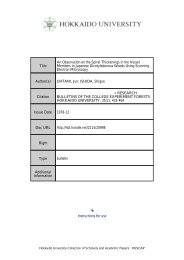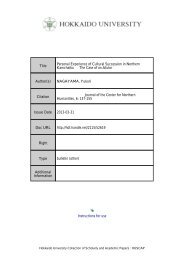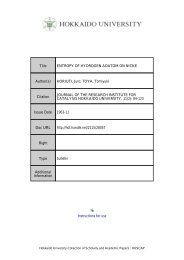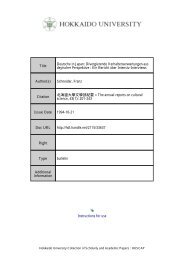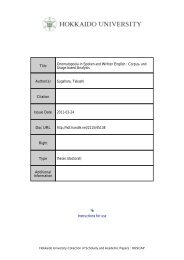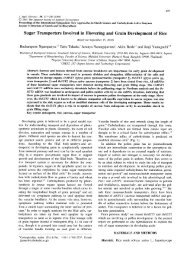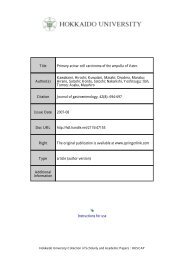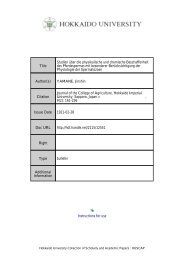The study on the isolation and culture of the protoplast from ...
The study on the isolation and culture of the protoplast from ...
The study on the isolation and culture of the protoplast from ...
Create successful ePaper yourself
Turn your PDF publications into a flip-book with our unique Google optimized e-Paper software.
Journ. Fac. Sci., Hokkaido Univ. Ser. V (Botany), 14(1): 95-114, 1987.<br />
<str<strong>on</strong>g>The</str<strong>on</strong>g> <str<strong>on</strong>g>study</str<strong>on</strong>g> <strong>on</strong> <strong>the</strong> isolati<strong>on</strong> <strong>and</strong> <strong>culture</strong> <strong>of</strong> <strong>the</strong> <strong>protoplast</strong><br />
<strong>from</strong> heterothallic Closterium<br />
Takuya N AKA Y AMA, Eriko ISHII<br />
<strong>and</strong> Hajime KAN AZA W A<br />
<str<strong>on</strong>g>The</str<strong>on</strong>g> enzymatic isolati<strong>on</strong> <strong>of</strong> <strong>protoplast</strong>s <strong>and</strong> <strong>the</strong>ir <strong>culture</strong> were studied in heterothallic<br />
strains <strong>of</strong> Closterium peracerosum-strigosum-littorale complex. <str<strong>on</strong>g>The</str<strong>on</strong>g> digesti<strong>on</strong> <strong>of</strong> <strong>the</strong>ir cell<br />
walls proceeded <strong>from</strong> divisi<strong>on</strong> scars distributed al<strong>on</strong>g <strong>the</strong> cell wall, <strong>and</strong> <strong>protoplast</strong>s were<br />
released out <strong>from</strong> <strong>on</strong>e <strong>of</strong> <strong>the</strong>se scars with remaining porti<strong>on</strong>s <strong>of</strong> <strong>the</strong> cell wall undigested.<br />
<str<strong>on</strong>g>The</str<strong>on</strong>g> yield <strong>of</strong> <strong>the</strong> <strong>protoplast</strong> varied according to cell age. When "post<strong>culture</strong>" (stati<strong>on</strong>ary<br />
<strong>culture</strong> with fresh medium overnight) was carried out prior to enzyme treatment, <strong>protoplast</strong>s<br />
were obtained in high yield <strong>from</strong> <strong>the</strong> cells <strong>of</strong> various ages. <str<strong>on</strong>g>The</str<strong>on</strong>g> maximum yields<br />
<strong>of</strong> <strong>the</strong> <strong>protoplast</strong> <strong>of</strong> mt+- <strong>and</strong> mC-cells were 80-90% <strong>and</strong> 70-80%, respectively, in this <str<strong>on</strong>g>study</str<strong>on</strong>g>.<br />
<str<strong>on</strong>g>The</str<strong>on</strong>g> cultivati<strong>on</strong> <strong>of</strong> <strong>protoplast</strong>s in <strong>the</strong> presence <strong>of</strong> 100 mM CaCl, led <strong>the</strong>m to initiate <strong>the</strong><br />
regenerati<strong>on</strong> <strong>of</strong> <strong>the</strong> cell walls. Scanning electr<strong>on</strong> microscopy revealed that <strong>the</strong> early stages<br />
<strong>of</strong> <strong>the</strong> cell wall regenerati<strong>on</strong> in this alga was similar to that in higher plants. Several<br />
physiological phenomena c<strong>on</strong>cerning <strong>the</strong> <strong>culture</strong> <strong>of</strong> <strong>the</strong> <strong>protoplast</strong>s <strong>of</strong> this alga were also<br />
examined.<br />
Protoplasts have been isolated enzymatically <strong>from</strong> many kinds <strong>of</strong> plants,<br />
<strong>culture</strong>d <strong>and</strong> regenerated into new individuals. <str<strong>on</strong>g>The</str<strong>on</strong>g>n <strong>the</strong>y have been used<br />
routinely as an important experimental tool in <strong>the</strong> underst<strong>and</strong>ing <strong>of</strong> physiology,<br />
development <strong>and</strong> morphogenesis <strong>of</strong> plant cells. Most <strong>of</strong> <strong>the</strong>se studies,<br />
however, have been d<strong>on</strong>e with higher plants, <strong>and</strong> <strong>protoplast</strong>s <strong>of</strong> lower plants<br />
have received less attenti<strong>on</strong>.<br />
Recently <strong>protoplast</strong>s have been isolated <strong>from</strong> many eukaryotic algae<br />
(reviewed by BERLINER, 1981, 1983). With regard to desmids, <strong>protoplast</strong>s<br />
have been derived <strong>from</strong> Cosmarium (CHARDARD, 1972), Micrasterias (BERLINER<br />
<strong>and</strong> WENC, 1976), Staurastrum <strong>and</strong> Netrium (BERLINER, 1978). For <strong>the</strong><br />
Closterium species, <strong>protoplast</strong>s have been isolated in C. acerosum (BERLINER,<br />
1978) <strong>and</strong> C. peracerosum-strigosum-littorale complex (KATO et al., 1983). All<br />
<strong>the</strong>se reports described mainly <strong>protoplast</strong> obtenti<strong>on</strong>s, but dealt little with<br />
<strong>culture</strong>s <strong>and</strong> regenerati<strong>on</strong>s <strong>of</strong> <strong>protoplast</strong>.<br />
Closterium species are interesting materials to <str<strong>on</strong>g>study</str<strong>on</strong>g> some biological<br />
problems. Several workers have studied morphologically, physiologically<br />
<strong>and</strong> genetically about several problems using Closterium. Use <strong>of</strong> <strong>protoplast</strong><br />
may c<strong>on</strong>tribute to <strong>the</strong>se studies. For example, <strong>the</strong> <strong>protoplast</strong> may be used to




